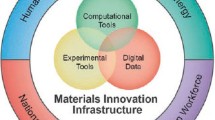Abstract
The mapping of the human genome is an important basis for the development of new medicals and medical treatments. Consequently, it has attracted tremendous research funding over the last decade. On June 2011, the Materials Genome Initiative was announced by the US President Obama as collaboration on modeling and advanced materials databases. Unfortunately, the materials genome was given a rather vague definition in the announcement. However, the materials genome should be defined in analogy with biological genomes and one may then conclude that: at any moment, the performance of a specific material depends on its chemical composition (inherent property stored in its genome) and its environment (external interactions–processing–conditions during usage). The materials genome should thus be defined as a set of information encoded in the language of thermodynamics obtained by careful assessment of experimental data and quantum mechanical calculations from which certain conclusions about the material can be drawn. The CALPHAD databases contain the thermodynamic and kinetic properties of a materials system. Such databases allow the prediction of materials structure as well as its response to processing and usage conditions, and are major parts of integrated computational materials engineering.




Similar content being viewed by others
References
Kaufman L, Bernstein H (1970) Computer calculation of phase diagrams. Academic Press, New York
Saunders N, Miodownik AP (1998) CALPHAD—a comprehensive guide. Pergamon Press, Oxford
National Research Council (2004) Accelerating technology transition—bridging the valley of death for materials and processes in defense systems. The National Academies Press, Washington DC
National Research Council (2008) Integrated computational materials engineering: a transformational discipline for improved competitiveness and national security. The National Academies Press, Washington DC
Stokes DE (1997) Pasteur’s quadrant—basic science and technological innovation. Brookings Institution Press, Washington DC
Borgenstam A, Höglund L, Ågren J et al (2000) DICTRA, a tool for simulation of diffusional transformation in alloys. J Phase Equilib 21:269–280
Villanueva W, Grönhagen K, Amberg G et al (2008) Multicomponent and multiphase modeling and simulation of reactive wetting. Phys Rev E 77:056313
Yeddu KH, Malik A, Ågren J et al (2012) Three-dimensional phase-field modeling of martensitic microstructure evolution in steels. Acta Mater 60:1538–1547
Calcagnotto M, Ponge D, Demir E et al (2010) Orientation gradients and geometrically necessary dislocations in ultrafine grained dual-phase steels studies by 2D and 3D EBSD. Mater Sci Eng A 527:2738–2746
Liss KL, Bartels A, Schreyer A et al (2003) High-energy X-rays: a tool for advanced bulk investigations in materials science and physics. Text Microstruct 35:219–252
Miller MK, Forbes RG (2009) Atom probe tomography. Mater Charact 60:461–469
Gibbs JW (1948) Collected works. Yale University Press, New Haven
van Laar JJ (1908) Melting or solidification curves in binary system. Z Phys Chem 63:216
Kubaschewski O, Evans ELL, Alcock CB (1967) Metallurgical thermochemistry. Pergamon Press, Oxford
Daniel RS (1965) JANAF thermochemical tables. Clearinghouse for federal scientific and technical information, Dow Chemical Company
Barin I, Knacke O, Kubaschewski O (1977) Themochemical properties of inorganic substances. Springer, Berlin
Hultgren R, Desai PD, Hawkins DT et al (1973) Selected values of the thermodynamic properties of the elements. American Society for Metals, Metals Park
Hultgren R, Desai PD, Hawkins DT et al (1973) Selected values of the thermodynamic properties of binary alloys. American Society for Metals, Metals Park
Eriksson G (1975) Thermodynamic studies of high temperature equilibria. Chem Scr 8:100–103
Lukas HL, Henig ET, Zimmermann B (1977) Optimization of phase diagrams by a least squares method using simultaneously different types of data. Calphad Comput Coupling Ph Diagr Thermochem 1:225–236
Evans LB, Boston JF, Britt HI et al (1979) ASPEN: an advanced system for process engineering. Comput Chem Eng 3:319–327
Pelton AD, Bale CW (1977) Computational techniques for the treatment of thermodynamic data in multicomponent systems and the calculation of phase equilibria. Calphad Comput Coupling Ph Diagr Thermochem 1:253–273
Sundman B, Jansson B, Andersson JO (1985) The thermo-calc databank system. Calphad Comput Coupling Ph Diagr Thermochem 9:153–190
Davies RH, Dinsdale AT, Gisby JA et al (2002) MTDATA—thermodynamic and phase equilibrium software from the national physical laboratory. Calphad Comput Coupling Ph Diagr Thermochem 26:229–271
Andersson JO, Ågren J (1992) Models for numerical treatment of multicomponent diffusion in simple phases. J Appl Phys 72:1350–1355
Campbell CE, Boettinger WJ, Kattner UR (2002) Development of a diffusion mobility database for Ni-base superalloys. Acta Mater 50:775–792
Razumoskiy VI, Ruban AV, Korzhavyi PA (2011) Effect of temperature on the elastic anisotropy of pure Fe and Fe0.9Cr0.1 random alloy. Phys Rev Lett 107:205504
Andersson DA, Simak SI, Skorodumova NV et al (2006) Optimization of ionic conductivity in doped ceria. Proc Natl Acad Sci USA 103:3518–3521
Xiong W, Hedström P, Selleby M et al (2011) An improved thermodynamic modeling of the Fe–Cr system down to zero Kelvin coupled with key experiments. Calphad Comput Coupling Ph Diagr Thermochem 35:355–366
Acknowledgments
The author would like to thank Professor Malin Selleby and associate Professors Joakim Odqvist and Annika Borgenstam from the Royal Institute of Technology for valuable suggestions. Funding within the Hero-m project supported by VINNOVA (the Swedish Governmental Agency for Innovation Systems), KTH, and Swedish industry is gratefully acknowledged.
Author information
Authors and Affiliations
Corresponding author
Additional information
SPECIAL ISSUE: Materials Genome
About this article
Cite this article
Ågren, J. The materials genome and CALPHAD. Chin. Sci. Bull. 59, 1635–1640 (2014). https://doi.org/10.1007/s11434-013-0108-2
Received:
Accepted:
Published:
Issue Date:
DOI: https://doi.org/10.1007/s11434-013-0108-2




